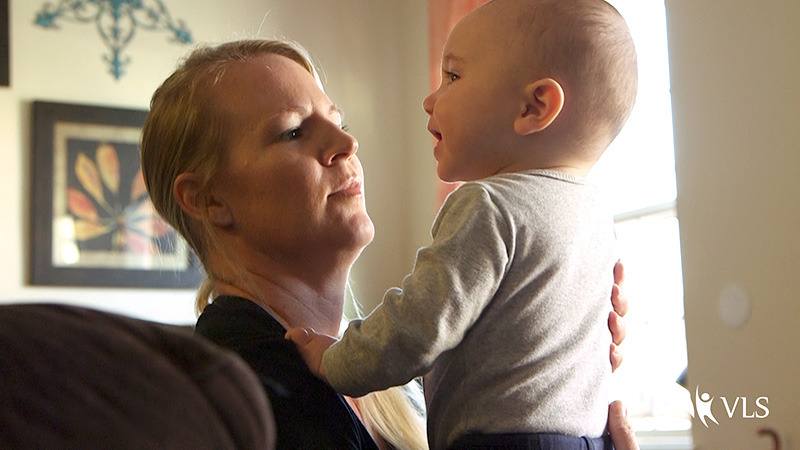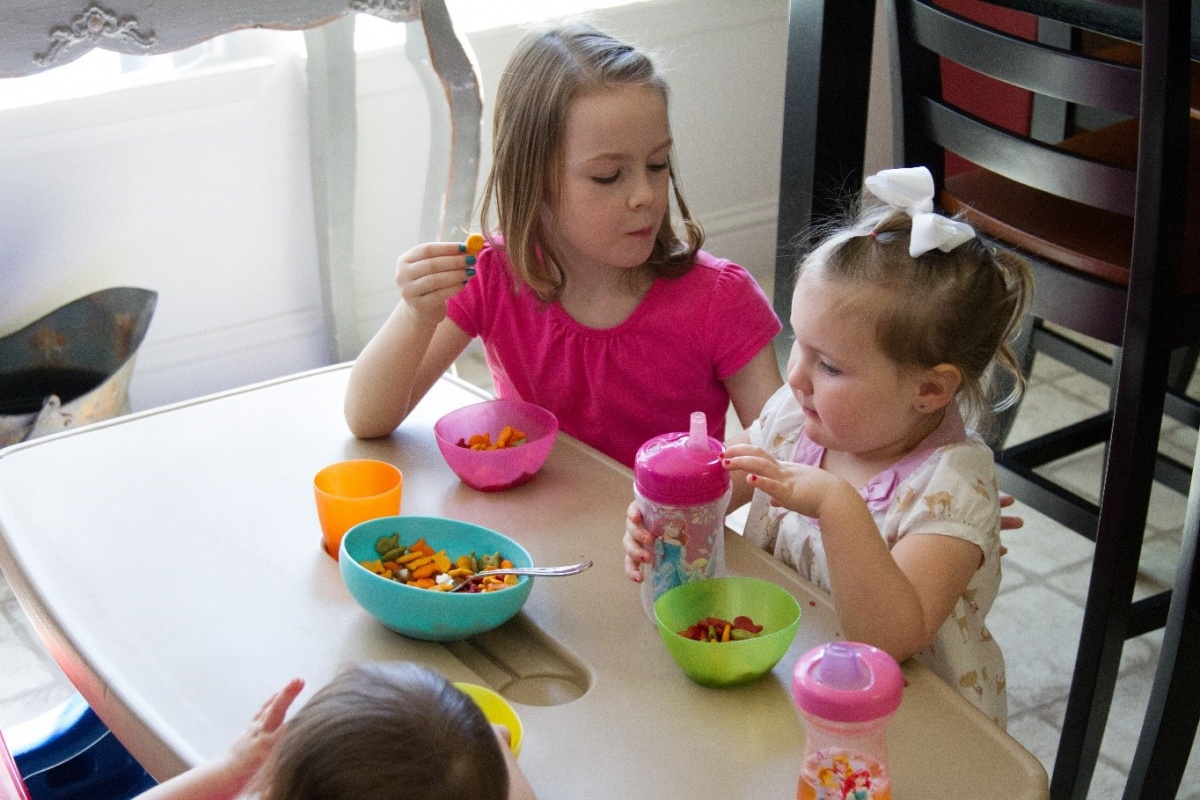- List characteristics of family child care environments that support children’s social-emotional development and learning.
- Explore resources that provide information about supporting social-emotional development across mixed-ages of children (infants, toddlers, preschool, and school-age).
- Discuss how to build a sense of community among the children in your family child care setting.
Learn
Know
As a family child care provider, you welcome children and their families into your home for daily care. Your home environment must meet their needs for safety, security, and a sense of belonging. At the same time, your home also serves as a place of love and security for your own family members. You may find yourself having to carefully plan your environment to provide a warm home for the children in your care and make space and time for your family.
Many family child care providers serve children who are at different ages and stages of development. At each stage, children are working on developing different social and emotional skills. As a responsive caregiver, your goal is to provide a healthy, safe environment for each child.
Infant and Toddler Social-Emotional Environment
 For infants and toddlers, creating a safe, secure environment where they can form a meaningful attachment to you is critical to their positive social and emotional development. The type of care environment you provide affects their social-emotional development. All children develop in individual ways, but all infants and toddlers need consistent, warm, nurturing care. Your home environment must meet their needs for feeding, diapering, following their cues for play, and allowing them to sleep when tired. You provide predictable, consistent care that forms a safe basis for infants and toddlers to learn to self-regulate, form attachments, and feel safe to explore the world around them. Infants and toddlers need lots of physical care and opportunities to have items from the environment “brought to them.” As infants become more mobile, you can arrange the environment to encourage safe exploration and play.
For infants and toddlers, creating a safe, secure environment where they can form a meaningful attachment to you is critical to their positive social and emotional development. The type of care environment you provide affects their social-emotional development. All children develop in individual ways, but all infants and toddlers need consistent, warm, nurturing care. Your home environment must meet their needs for feeding, diapering, following their cues for play, and allowing them to sleep when tired. You provide predictable, consistent care that forms a safe basis for infants and toddlers to learn to self-regulate, form attachments, and feel safe to explore the world around them. Infants and toddlers need lots of physical care and opportunities to have items from the environment “brought to them.” As infants become more mobile, you can arrange the environment to encourage safe exploration and play.
Some tips for your infant and toddler environment:
- Provide board books that reflect children’s cultural backgrounds. Hold the child on your lap and discuss pictures of faces when looking at books together: “He looks surprised to see that new toy.”
- Provide a mirror and describe the child’s feelings, “Look, I see your smile—you’re so happy!”
- Provide infant-toddler toys that promote social interaction with you and other children, “You press the button on the busy box, then it is Jorge’s turn.”
- Engage in conversations during feedings, snack times, diapering, dressing, etc.
- Follow the infant’s or toddler’s lead: allow the child to socially disengage when ready.
- Always comfort the child who is upset, frightened, or overwhelmed, and use gentle hugs and a soothing voice.
- Acknowledge the child’s efforts to engage with you. Look where the child is pointing and comment on or name what she or he is pointing at. Respond to any coos or other vocalizations. This "serve and return" meaningful interaction helps build brain architecture.
- Provide opportunities for infants and toddlers to make choices (e.g., toys, snack foods, etc.) and explore safely in your home.
- Respond to the child consistently as this helps build trust.
- Provide activities such as group singing, movement, etc. for children to build relationships with peers.
- Always acknowledge when children share or engage in other thoughtful behaviors.
You may want to reference the posters from the Center for Early Childhood Mental Health Consultation (CEMHC) that are included with this lesson: Social Emotional Tips for Providers Caring for Infants and Social Emotional Tips for Providers Caring for Toddlers as examples of how to use caregiving routines in your daily environment to support a healthy social-emotional development.
Environments that Support Social Emotional Development
Preschoolers’ Social-Emotional Environment
Preschoolers’ social-emotional development is also dependent on being in a safe, warm, nurturing environment. Preschoolers are developing at a fast pace and are able to learn from modeling and imitation. You may hear them repeating things they have heard from home, TV shows, and you! It’s critical that as a family child care provider, you remember that what you say and how you say it has a great impact on the social development of the children in your care.
Schedules and Routines:
- The schedule should be simple and include predictable routines. This does not mean it must always be strictly followed, but it should be one children can count on regularly.
- Provide visual reminders of the schedule.
- The indoor and outdoor environment should promote positive social interactions among the children and with you.
- The environment must be safe—free from dangerous materials or potential for harm.
- Materials and toys should be logically grouped (e.g., puzzles are near a table, messy art supplies are near a water source, etc.).
- There are only a few transitions throughout the day. Children get advance notice (“In three minutes, we will clean up and get ready for lunch”) when a transition is about to occur.
Activities and materials:
- Activities and materials are rotated to engage preschool children and maximize their attention.
- Materials and toys are developmentally appropriate.
- There are a variety of toys that promote social interactions (e.g., cars and trucks, water toys, blocks, dress-up clothes, and props) and some toys that promote individual play (e.g., writing materials, puzzles).
- There are enough toys and materials for children to play with.
- Materials and toys are purposefully arranged to create opportunities for children to engage in social interactions with one another and with you (e.g., eating lunch family style so children ask each other to pass bowls or plates of food).
Responsive Caregiving
- Support turn-taking with toys, equipment, and materials.
- Encourage children to talk to one another to solve problems.
- Model appropriate language to help children deal with conflict or solve problems with each other.
- Follow children’s interests and incorporate their interests into the environment.
- Encourage children to share their thoughts and express their feelings around events (this may be especially important if children are dealing with a parent’s deployment or absence).
- Validate children’s feelings and thoughts.
- Encourage friendships among the children and their older and younger friends in your home. This promotes a sense of community in your family child care home. Everyone belongs and everyone contributes to a positive environment.
- Encourage children to create and build friendships; watch for children who seem to enjoy playing with one another and comment on their play (“you are a good friend to Yuri because you always give him a turn on the tricycle”).

Fostering Social Emotional Development in Preschoolers
School Age Children’s Social-Emotional Environment
Your family child care home is a place where all children can feel a sense of belonging and community. Although school-age children may seem more socially and emotionally mature than the younger children you care for, they still make mistakes. It is important that you build relationships with all the children in your family child care home. Creating a safe, emotional climate is important. You help create a sense of community when you create caring relationships among all the children in your care, provide structure and safety, and set reasonable limits and boundaries.
As they grow socially and emotionally, school-age children need an environment where:
- They are always greeted by name as they enter your home. Be sure to also say good-bye when they leave to go home. This shows that you recognize and care for them as individuals.
- Help the school-age children make decisions about the rules you have for them in your home (e.g., tech time, homework time, etc.). They are old enough to help you create expectations. Have them write the rules on paper and post them (and be sure to share with families).
- Allow children to express their feelings and carefully listen to them. Often at this age children are learning to navigate social issues at school or in the community. You are a trusted adult they can turn to for help and guidance.
- Within your environment, show your care and acceptance of each child. Display their artwork, projects, etc. Share their enthusiasm about special topics or events with their families.
- Be sensitive to what is happening with their military family. School-age children understand separation due to training missions, deployment, etc. They may have heard about upcoming disruptions or family moves. Be warm and nurturing when children are talking about difficult issues. Provide space for school-age children to be alone if they need it.
- Encourage school-age children to assist younger children. The environment in a family child care setting provides a chance for older children to model socially appropriate behaviors for the younger children.
- Have a zero-tolerance policy on bullying. Be aware of bullying and the problems it causes for children who are bullied as well as children who engage in bullying behavior. Bullying is a significant problem for some children and youth. It may occur through social media as well as in school. Stay informed and aware of resources in your community that help children and families with this issue. You may be aware of incidences that school-age children are worried about. Never dismiss a child who is concerned about bullying. Visit the website stopbullying.gov to learn more about how to prevent and respond to bullying.
SEE
Creating Community in Family Child Care
DO
Summary
In this lesson, you learned about creating a high-quality family child care environment where infants, toddlers, preschoolers, and school-age children learn and grow socially and emotionally. Children who are socially and emotionally capable are more likely to do well in school and in life. As a significant adult caregiver, you form loving, nurturing attachments to the children in your care. You are a role model for the children. Along with their family, you shape their outlook on peers and adults. They are watching and learning from you all the time. The warm, responsive interactions you promote in your family child care environment plays an important part in the healthy social and emotional development of each child.
The Learn section above outlines several things you can do within your family child care environment to support the social and emotional development of infants, toddlers, preschoolers and school-age children. Spend time trying out these strategies in your family child care program and reflect on how they influence children’s interactions with you and each other.
Explore
Observing your indoor and outdoor learning environment will allow you to assess the community aspect of your program. Read and complete the activity, Observe: The Environment. How might you use this information to make any needed changes to the social-emotional environment in your setting?
Apply
Family child care environments are ideal for creating a true sense of a small community. Just as in a family, in your family child care home, there may be children of different ages spending time together in play activities and daily routines. Use the handout, Maintaining a Safe and Caring Community, and write down how you might deal with the issues presented. Discuss your ideas with your trainer, coach or family child care administrator.
Glossary
Demonstrate
Berk, L.E. (2013). Child Development (9th ed.). Upper Saddle River, NJ: Pearson Education Inc.
Center for Early Childhood Mental Health Consultation. Georgetown University Center for Child and Human Development. Retrieved from: https://www.ecmhc.org/
Center on the Developing Child (2017). Harvard University. Serve and Return Retrieved from https://developingchild.harvard.edu/science/key-concepts/serve-and-return/
Dodge, D. T., Rudick, S., & Colker, L. J. (2009). The Creative Curriculum for Family Child Care (2nd ed.). Washington, DC: Teaching Strategies.
McCloud, C. (2006). Have You Filled a Bucket Today: A guide to daily happiness for kids. Northville, MI: Ferne Press.
Jarolimek, J. (2001). Teaching and Learning in the Elementary School (7th ed.). Upper Saddle River, NJ: Merrill Prentice Hall.
Trawick-Smith, J. W. (2014). Early Childhood Development: A Multicultural Perspective (6th ed.). Upper Saddle River, NJ: Merrill Prentice Hall.


